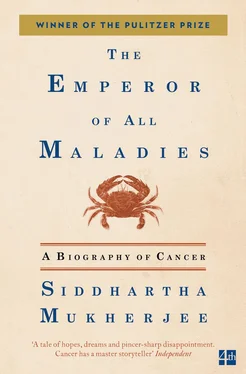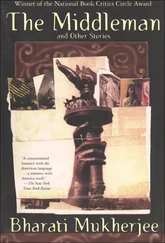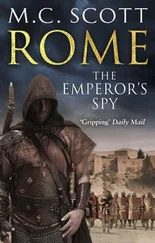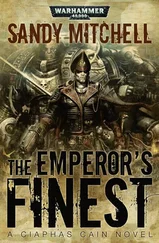
Sidney Farber was born in Buffalo, New York, in 1903, one year after Virchow’s death in Berlin. His father, Simon Farber, a former bargeman in Poland, had immigrated to America in the late nineteenth century and worked in an insurance agency. The family lived in modest circumstances at the eastern edge of town, in a tight-knit, insular, and often economically precarious Jewish community of shop owners, factory workers, bookkeepers, and peddlers. Pushed relentlessly to succeed, the Farber children were held to high academic standards. Yiddish was spoken upstairs, but only German and English were allowed downstairs. The elder Farber often brought home textbooks and scattered them across the dinner table, expecting each child to select and master one book, then provide a detailed report for him.
Sidney, the third of fourteen children, thrived in this environment of high aspirations. He studied both biology and philosophy in college and graduated from the University of Buffalo in 1923, playing the violin at music halls to support his college education. Fluent in German, he trained in medicine at Heidelberg and Freiburg, then, having excelled in Germany, found a spot as a second-year medical student at Harvard Medical School in Boston. (The circular journey from New York to Boston via Heidelberg was not unusual. In the mid-1920s, Jewish students often found it impossible to secure medical-school spots in America—often succeeding in European, even German, medical schools before returning to study medicine in their native country.) Farber thus arrived at Harvard as an outsider. His colleagues found him arrogant and insufferable, but, he too, relearning lessons that he had already learned, seemed to be suffering through it all. He was formal, precise, and meticulous, starched in his appearance and his mannerisms and commanding in presence. He was promptly nicknamed Four-Button Sid for his propensity for wearing formal suits to his classes.
Farber completed his advanced training 23in pathology in the late 1920s and became the first full-time pathologist at the Children’s Hospital in Boston. He wrote a marvelous study on the classification of children’s tumors and a textbook, The Postmortem Examination, widely considered a classic in the field. By the mid-1930s, he was firmly ensconced in the back alleys of the hospital as a preeminent pathologist—a “doctor of the dead.”
Yet the hunger to treat patients still drove Farber. And sitting in his basement laboratory in the summer of 1947, Farber had a single inspired idea: he chose, among all cancers, to focus his attention on one of its oddest and most hopeless variants—childhood leukemia. To understand cancer as a whole, he reasoned, you needed to start at the bottom of its complexity, in its basement. And despite its many idiosyncrasies, leukemia possessed a singularly attractive feature: it could be measured.
Science begins with counting. To understand a phenomenon, a scientist must first describe it; to describe it objectively, he must first measure it. If cancer medicine was to be transformed into a rigorous science, then cancer would need to be counted somehow—measured in some reliable, reproducible way.
In this, leukemia was different from nearly every other type of cancer. In a world before CT scans and MRIs, quantifying the change in size of an internal solid tumor in the lung or the breast was virtually impossible without surgery: you could not measure what you could not see. But leukemia, floating freely in the blood, could be measured as easily as blood cells—by drawing a sample of blood or bone marrow and looking at it under a microscope.
If leukemia could be counted, Farber reasoned, then any intervention—a chemical sent circulating through the blood, say—could be evaluated for its potency in living patients. He could watch cells grow or die in the blood and use that to measure the success or failure of a drug. He could perform an “experiment” on cancer.
The idea mesmerized Farber. In the 1940s and ’50s, young biologists were galvanized by the idea of using simple models to understand complex phenomena. Complexity was best understood by building from the ground up. Single-celled organisms such as bacteria would reveal the workings of massive, multicellular animals such as humans. What is true for E. coli 24[a microscopic bacterium], the French biochemist Jacques Monod would grandly declare in 1954, must also be true for elephants.
For Farber, leukemia epitomized this biological paradigm. From this simple, atypical beast he would extrapolate into the vastly more complex world of other cancers; the bacterium would teach him to think about the elephant. He was, by nature, a quick and often impulsive thinker. And here, too, he made a quick, instinctual leap. The package from New York was waiting in his laboratory that December morning. As he tore it open, pulling out the glass vials of chemicals, he scarcely realized that he was throwing open an entirely new way of thinking about cancer.
“A monster more insatiable than the guillotine”
The medical importance of leukemia 25has always been disproportionate to its actual incidence. . . . Indeed, the problems encountered in the systemic treatment of leukemia were indicative of the general directions in which cancer research as a whole was headed.
—Jonathan Tucker, Ellie: A Child’s Fight Against Leukemia
There were few successes in the treatment 26of disseminated cancer. . . . It was usually a matter of watching the tumor get bigger, and the patient, progressively smaller.
—John Laszlo, The Cure of Childhood Leukemia: Into the Age of Miracles
Sidney Farber’s package of chemicals happened to arrive at a particularly pivotal moment in the history of medicine. In the late 1940s, a cornucopia of pharmaceutical discoveries 27was tumbling open in labs and clinics around the nation. The most iconic of these new drugs were the antibiotics. Penicillin, that precious chemical that had to be milked to its last droplet during World War II (in 1939, the drug was reextracted 28from the urine of patients who had been treated with it to conserve every last molecule), was by the early fifties being produced in thousand-gallon vats. In 1942, when Merck had shipped 29out its first batch of penicillin—a mere five and a half grams of the drug—that amount had represented half of the entire stock of the antibiotic in America. A decade later, penicillin 30was being mass-produced so effectively that its price had sunk to four cents for a dose, one-eighth the cost of a half gallon of milk.
New antibiotics followed in the footsteps of penicillin: chloramphenicol in 1947 31, tetracycline in 1948 32. In the winter of 1949, when yet another miraculous antibiotic, streptomycin, was purified out of a clod of mold from a chicken farmer’s barnyard, Time magazine splashed the phrase “The remedies are in our own backyard,” 33prominently across its cover. In a brick building on the far corner 34of Children’s Hospital, in Farber’s own backyard, a microbiologist named John Enders was culturing poliovirus in rolling plastic flasks, the first step that culminated in the development of the Sabin and Salk polio vaccines. New drugs appeared at an astonishing rate: by 1950, more than half the medicines 35in common medical use had been unknown merely a decade earlier.
Perhaps even more significant than these miracle drugs, shifts in public health and hygiene also drastically altered the national physiognomy of illness. Typhoid fever 36, a contagion whose deadly swirl could decimate entire districts in weeks, melted away as the putrid water supplies of several cities were cleansed by massive municipal efforts. Even tuberculosis 37, the infamous “white plague” of the nineteenth century, was vanishing, its incidence plummeting by more than half between 1910 and 1940, largely due to better sanitation and public hygiene efforts. The life expectancy of Americans 38rose from forty-seven to sixty-eight in half a century, a greater leap in longevity than had been achieved over several previous centuries.
Читать дальше













